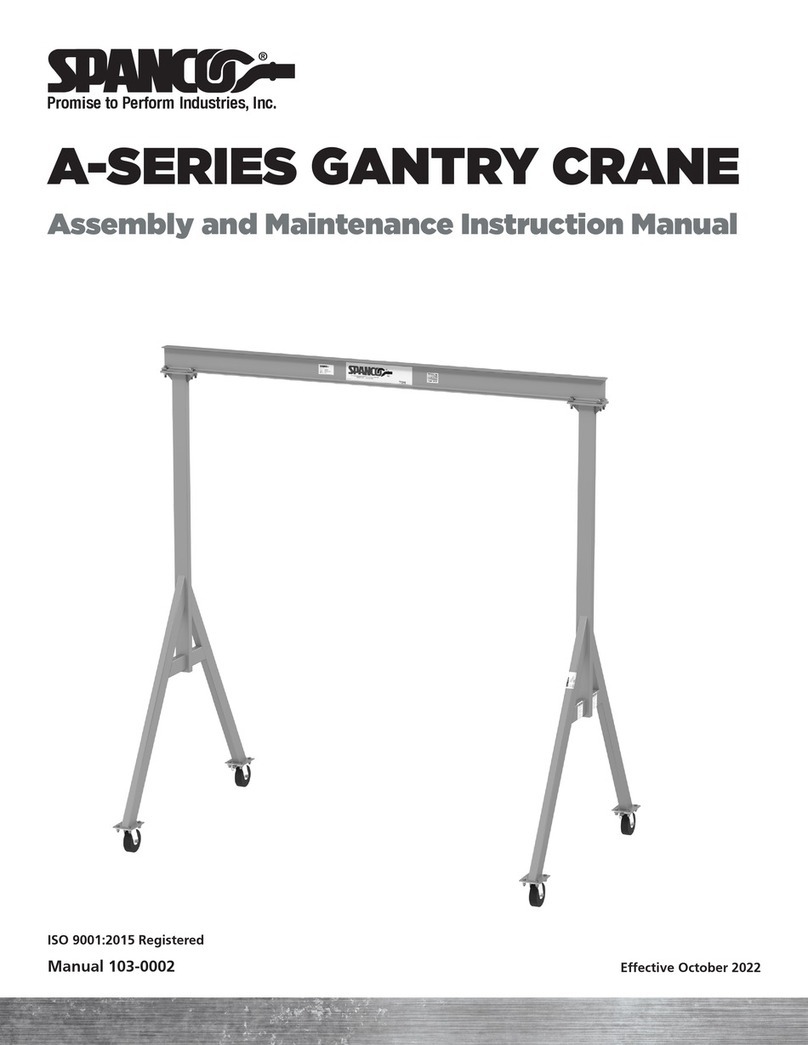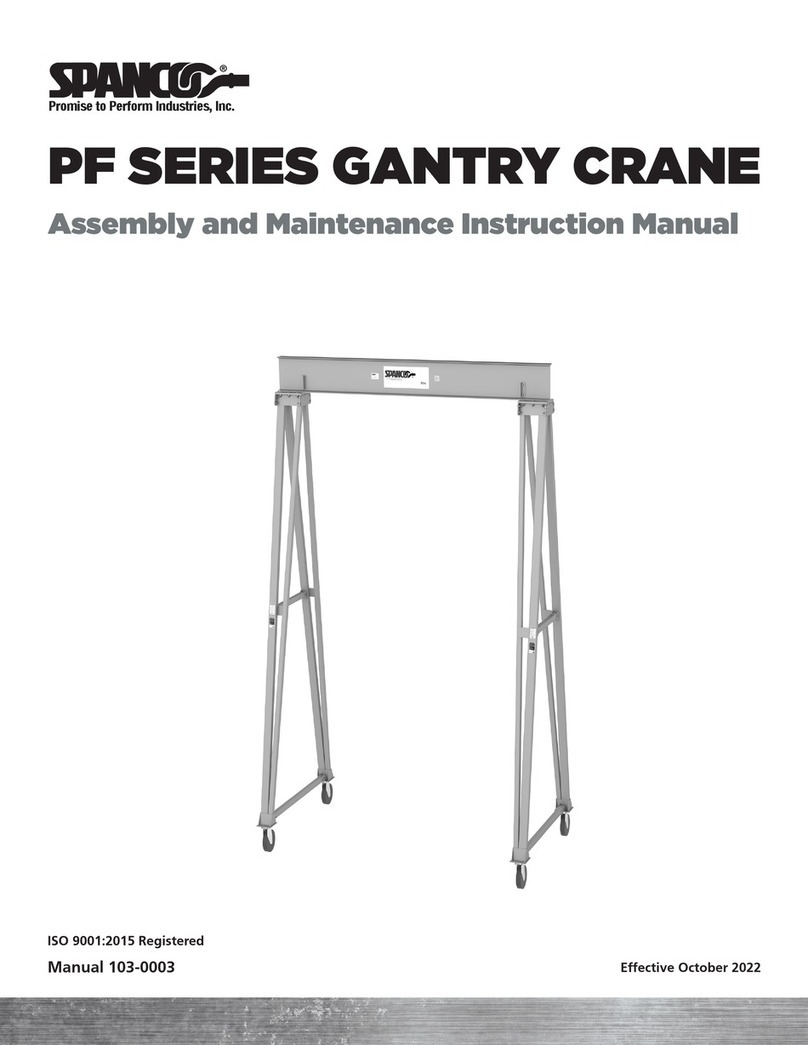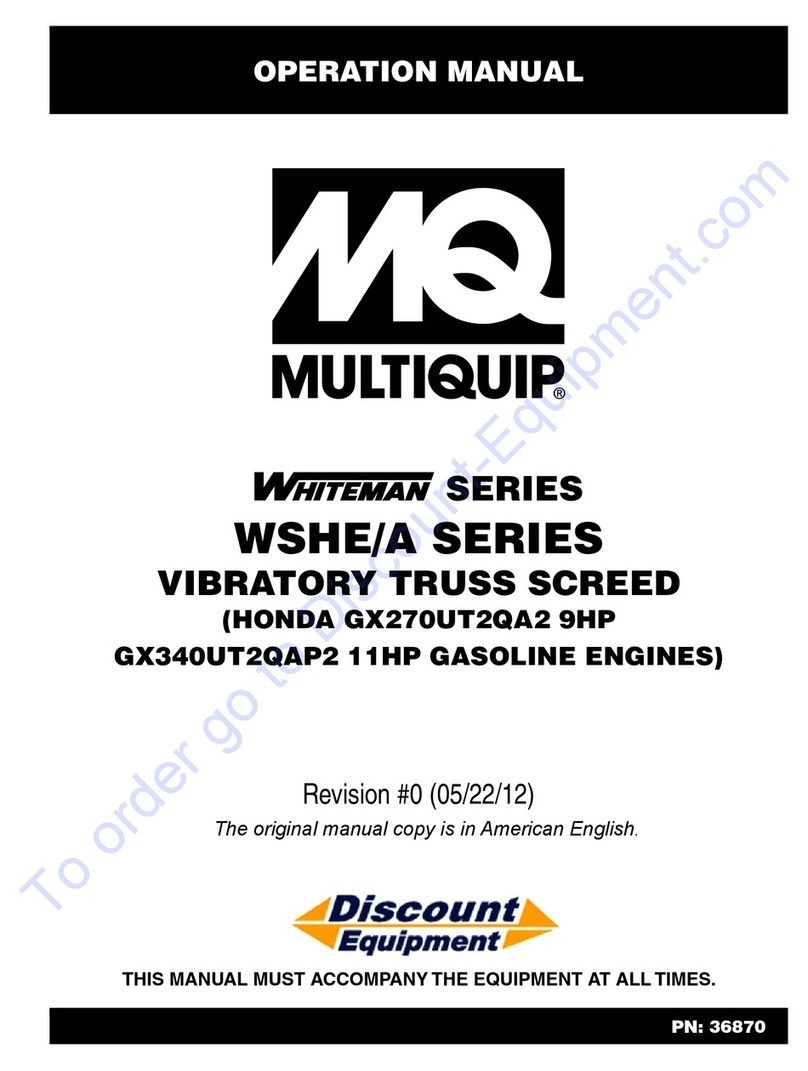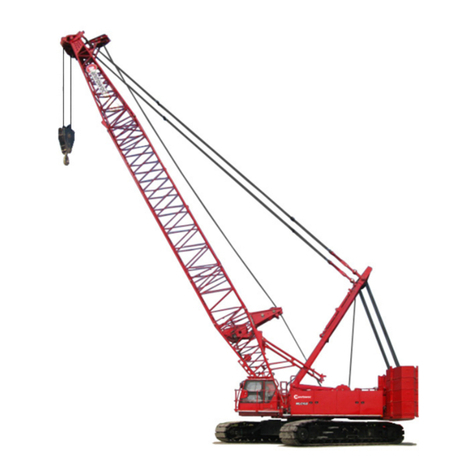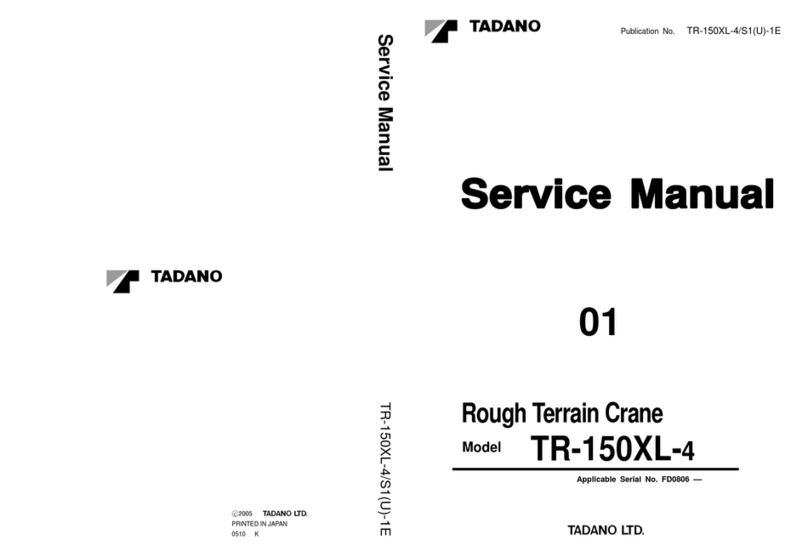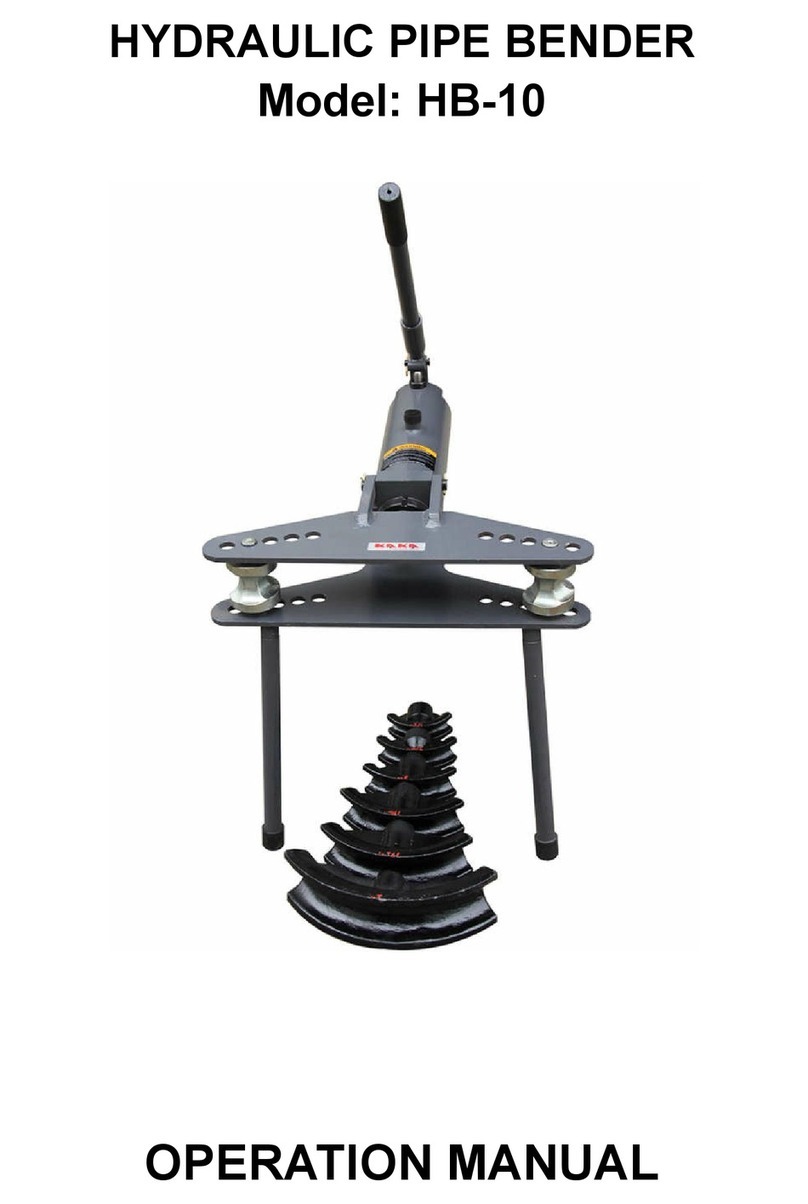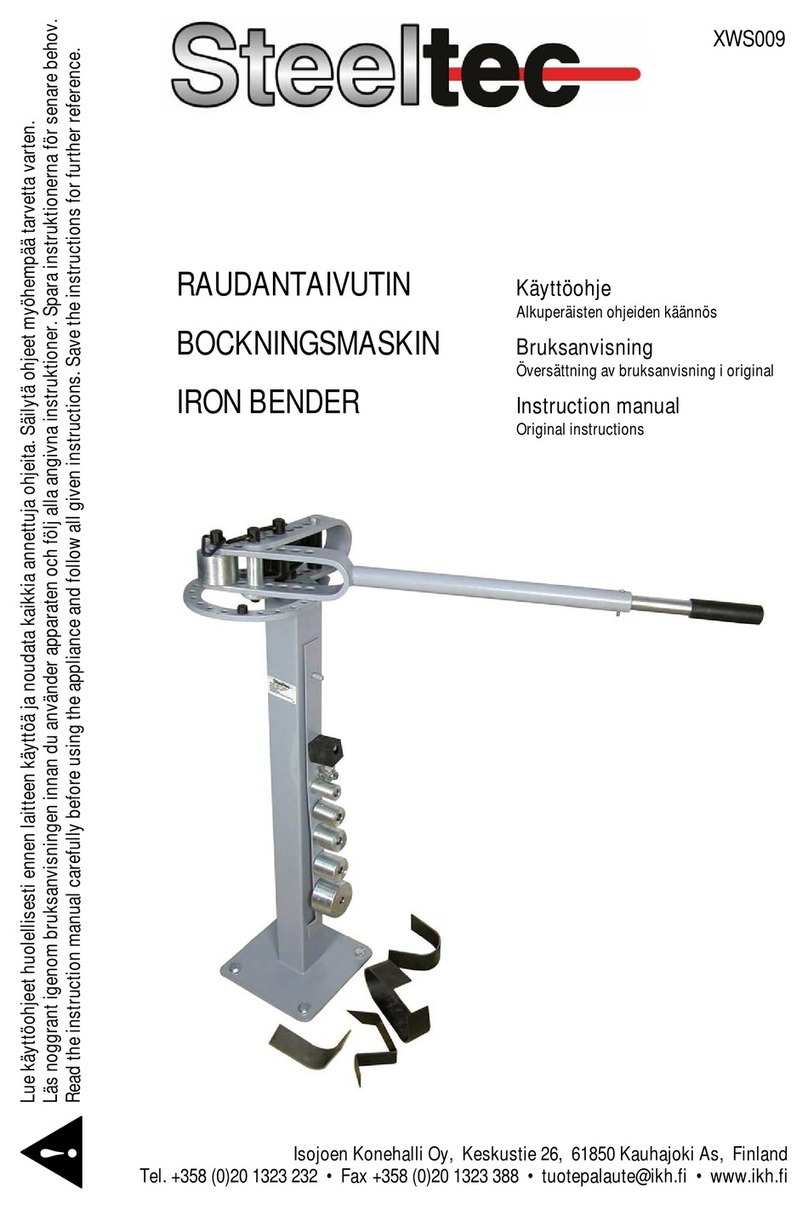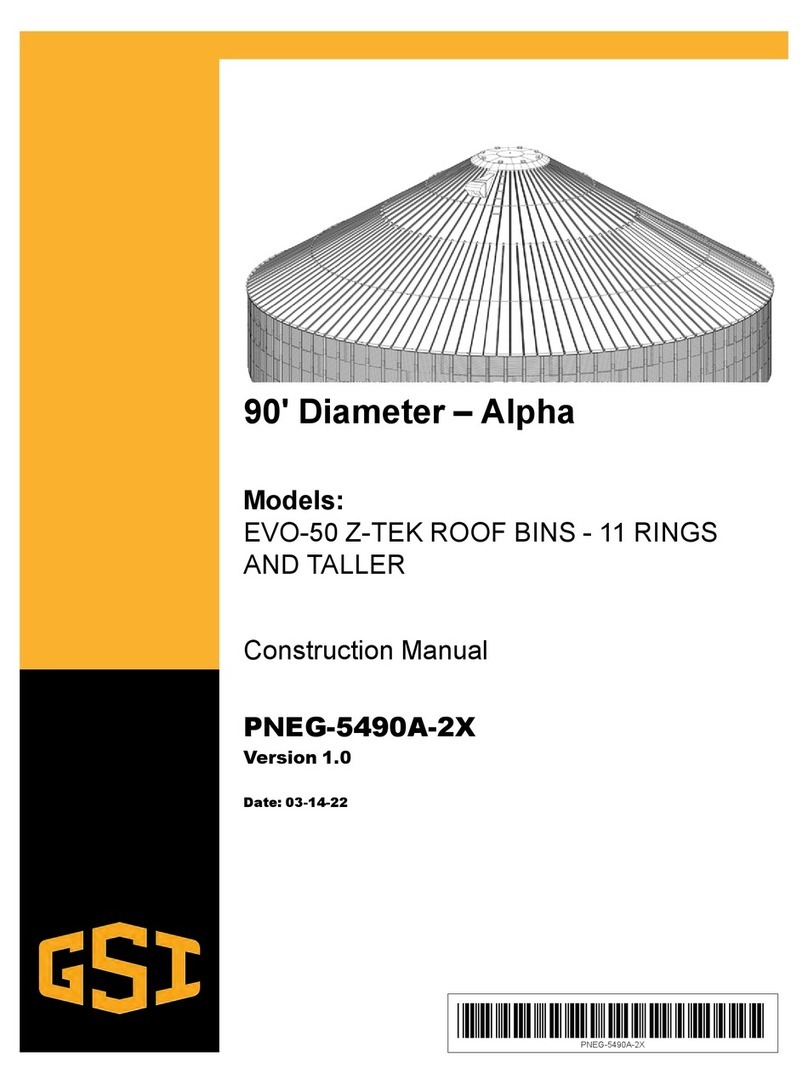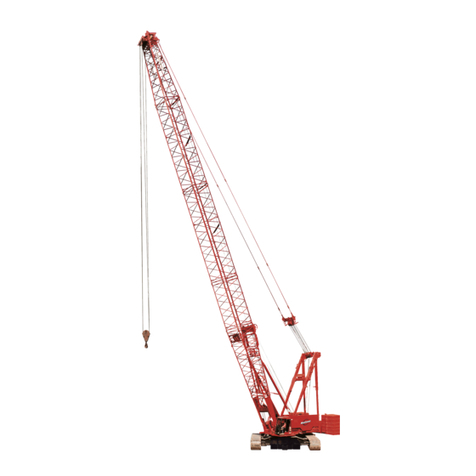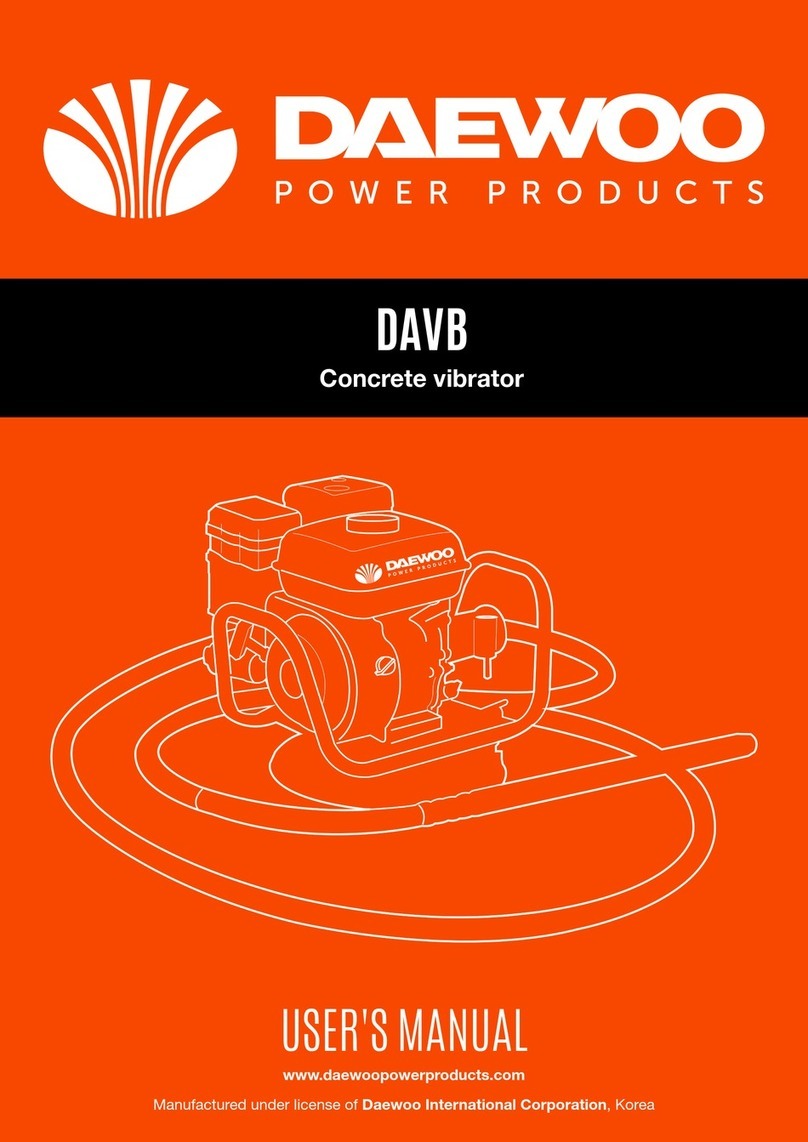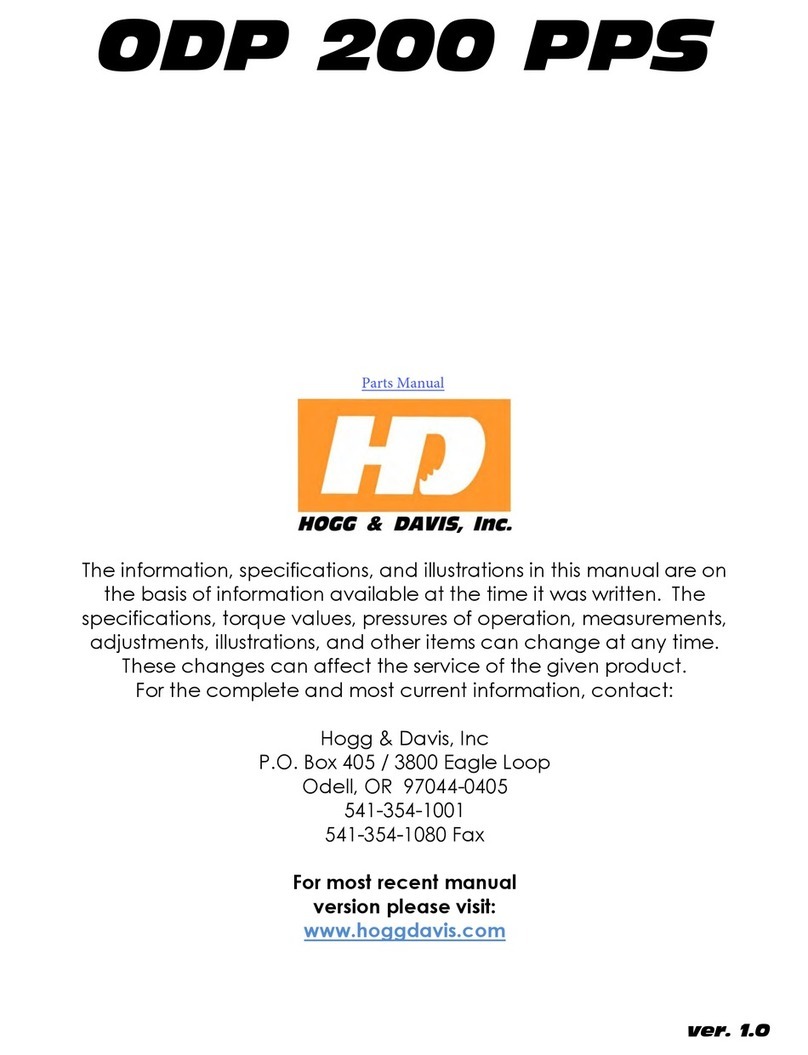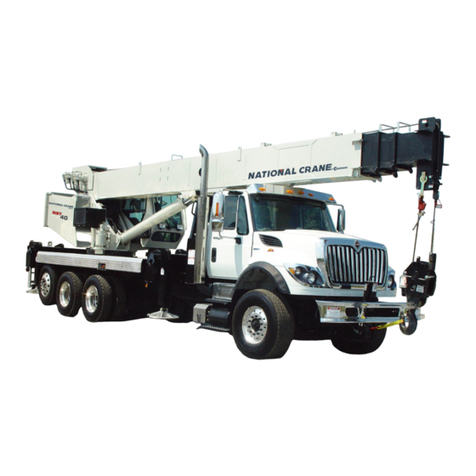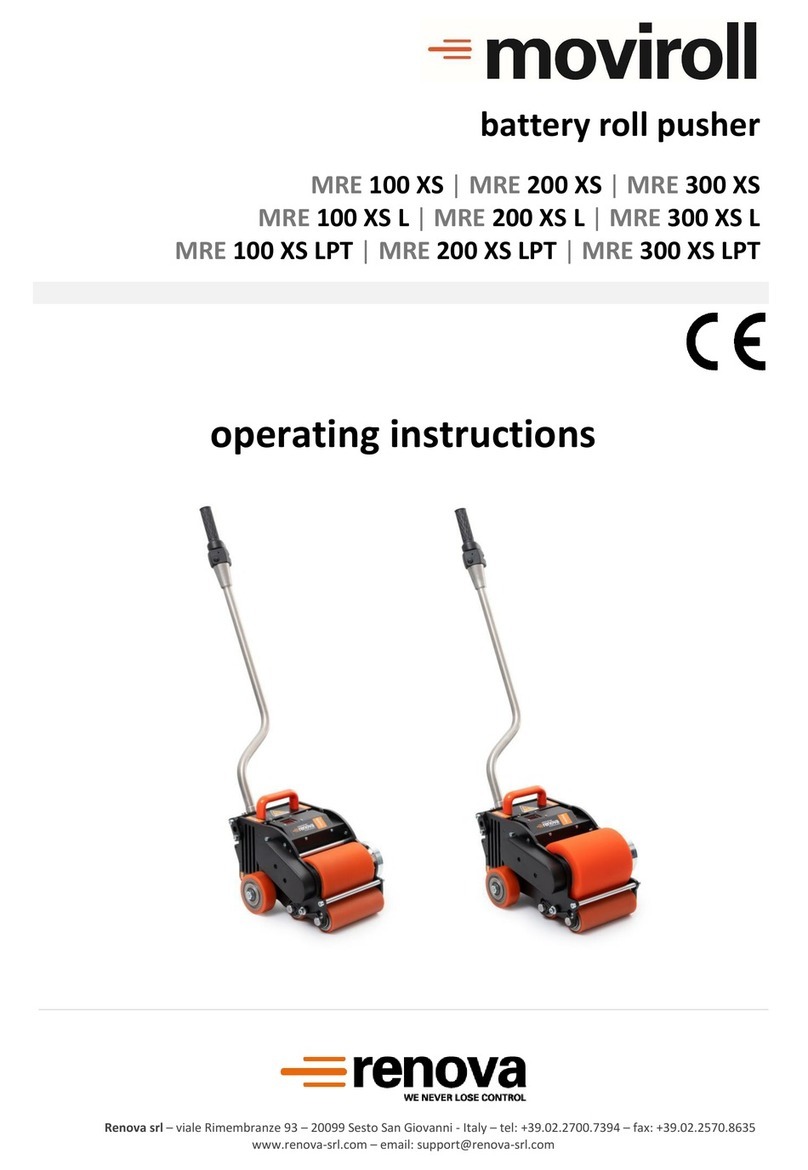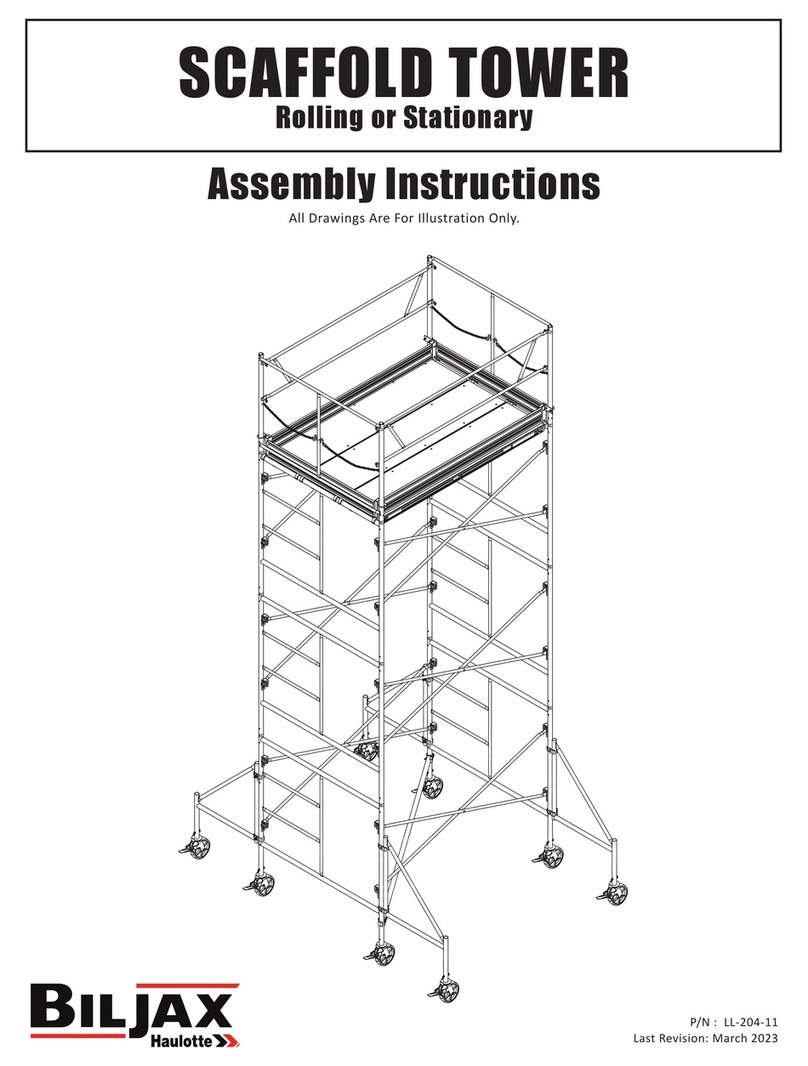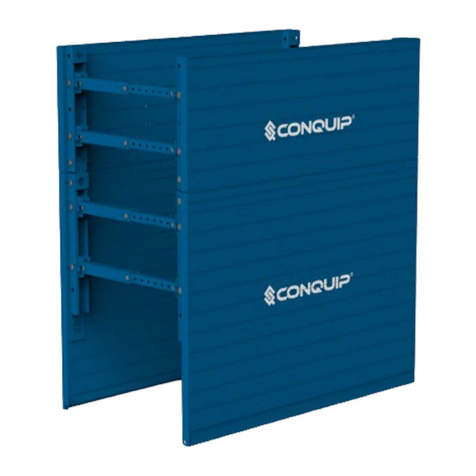Spanco T Series User manual

ISO 9001:2015 Registered
Manual 103-0001
Assembly and Maintenance Instruction Manual
Effective Date: September 2022
T-SERIES GANTRY CRANE
Promise to Perform Industries, Inc.

i Rigid Lifelines®Traveling Bridge Anchor Track™System | 1-800-869-2080 1-800-869-2080 | Rigid Lifelines®Traveling Bridge Anchor Track™System ii
i Spanco®T-Series Gantry Crane • 1-800-869-2080 • Spanco.com
SPANCO GANTRY CRANE CONDITIONS OF USE AND WARNINGS STATEMENT
1. Read, understand, and follow the manual, assembly drawings, and warnings provided with your system before
beginning installation, use, or disassembly. Follow all instructions carefully.
2. This manual, and any other instructions, must be provided to the user(s) of this equipment. The user(s) must understand
the equipment’s proper use and limitations.
3. This crane is engineered to accommodate a standard hoist and a standard hoist weight. The standard hoist weight is
calculated at 15 percent of the crane’s rated capacity. Please inform Spanco if hoist weight exceeds 15 percent of the
crane’s rated capacity, or if the lifting speed exceeds 50 FPM.
4. Motorized trolley travel is available for PF-Series and T-Series Gantry Cranes.
5. ”Sidewinder” hoists or low headroom hoists with motors that are parallel to the beam can potentially impart large
torques (twisting moments) to the beam that can cause beam twisting and oscillations. Hoist inverter controls are heavily
recommended for all “sidewinder” hoists or low headroom hoists with motors that are parallel to the beam installed on
beam lengths over 12 feet.
NOTE: To eliminate any form of beam oscillation, use only an inverter controlled hoist of this type.
6. Power Drive options for motorized gantry travel are available for PF-Series Gantry Cranes only. Review Power Drive
installation instructions in the separate Power Drive instruction manual.
7. Each component and system must be employed and maintained in accordance with all OSHA and ANSI standards.
8. Use a hoist with the same or lower capacity rating as the gantry crane. Do not lift more than the rated crane capacity.
9. The rated capacity is displayed on a label on the Spanco system. Exceeding the capacities displayed on this label can
result in serious injury or death.
10. There should never be any type of loading past the end stops for any reason.
11. Never apply an off-plumb load to the system.
12. Always check for overhead hazards, such as power lines, trees, equipment, overhead structures, or walls, before using or
moving a portable system.
13. Never use this system as fall protection or for lifting, hoisting, or carrying personnel.
14. When moving the gantry under load, keep the load in the center of the beam and as close to the ground as possible.
15. Before moving the gantry under load, remove any obstacles and ensure that the load is not attached to the floor.
16. Spanco Gantry Cranes are designed to be moved manually. Do not push or pull the gantry with a lift truck or other
vehicle.
17. When moving a gantry crane under load, push the gantry; do not push or pull the suspended load.
18. Never exceed two people pushing an Aluminum gantry crane.
19. Do not disassemble the gantry or adjust the height, span, or caster frame spread (if applicable) when the gantry is under
load.

i Rigid Lifelines®Traveling Bridge Anchor Track™System | 1-800-869-2080 1-800-869-2080 | Rigid Lifelines®Traveling Bridge Anchor Track™System ii
Spanco.com • 1-800-869-2080 • Spanco®T-Series Gantry Crane ii
SPANCO GANTRY CRANE CONDITIONS OF USE AND WARNINGS STATEMENT
20. Do not stand under the gantry when it is being adjusted in height, span, or caster frame spread.
21. Do not stand or walk under a suspended load.
22. Caster frame spread must be a minimum of 40 percent of the overall height (T-Series only).
23. Adjustments and repairs must be made in an area that does not interfere with operation.
24. Do not load the gantry on an incline or move a loaded gantry onto an inclined surface.
25. Do not allow the load to swing or roll against the gantry support members.
26. Do not allow the hoist trolley to strike the end stops or gantry supports at any time.
27. The system must be tied down if exposed to winds exceeding 30 miles per hour. Spanco considers it an unsafe practice
to operate cranes in winds over 15 miles per hour. Although the drive may work in speeds exceeding 15 miles per
hour, Spanco does not recommend using any crane in winds over 15 miles per hour for safety reasons. If quoted
for a pre-defined wind speed, the drive components have been designed for an approximate wind speed. It is the
responsibility of others to generate a risk assessment of wind conditions and part stability, and to generate a lifting plan
that accounts for the sail effect of the part being lifted and the length of the cable the part is suspended on. Notify
Spanco if the system will be subjected to constant buffeting winds.
28. Although Spanco may provide components that are intended for service in a specific environment, it is the customer’s
responsibility to confirm that the provided Spanco system and components will work in and are acceptable for their
specific application and environment.
29. Before each use, inspect the system for bent, broken, cracked, or missing components.
30. Thoroughly inspect the system annually per OSHA law.
31. Per OSHA law, load testing must be performed before the system can be placed into service.
32. Engineering of any attachment points must be done by others.
33. Component appearances and dimensions shown are approximate and subject to change without notice. All literature
dimensions are developed using standard components for the spans and capacities. Substitution of optional trolleys or
other components will affect certain dimensions.
34. Never deviate from the above unless you have written permission and authorization from Spanco.

iii Rigid Lifelines®Traveling Bridge Anchor Track™System | 1-800-869-2080 1-800-869-2080 | Rigid Lifelines®Traveling Bridge Anchor Track™System 1
iii Spanco®T-Series Gantry Crane • 1-800-869-2080 • Spanco.com
Follow the Inspection Checklists in this manual: review the Before Each Use Inspection Checklist on page 19 before each
use and review the Annual Inspection Checklist on page 20 annually.
SYSTEM APPLICATIONS
The Spanco system is used for material handling applications. This material handling system is labeled with a maximum rated
capacity and is designated for Class C service as defined by the CMAA; follow all limitations as noted on system labels.
STANDARDS AND COMPLIANCE
Please refer to local, state, and federal (OSHA) requirements governing occupational safety for additional information
regarding material handling. The Spanco system meets or exceeds the requirements set forth in OSHA 1910.179, ANSI
B30.11, and CMAA 70.
REQUIRED TRAINING
This system is intended to be used by people who are trained in its correct application and use. It is the responsibility of the
users and the users’ management to ensure that they are familiar with OSHA law and these instructions, and that they are
trained in the correct use and care of this equipment. Authorized users must also be aware of the operating characteristics,
application limits, and the consequences of improper use, which can result in serious injury or death. All users must read and
understand CMAA 79 Crane Operator’s Manual.
Every material handling application must be OSHA compliant. Safety and training measures may include, but are not limited
to:
• Operator certification training
• Operator evaluation program
• Hand signal protocols if required
• Lock-out/Tag-out training
The above list is not a comprehensive list. Specific applications may need to include additional protocols. For more information
on how to set up a proper lift plan within your facility, follow CMAA 79
Crane Operator’s Manual.

iii Rigid Lifelines®Traveling Bridge Anchor Track™System | 1-800-869-2080 1-800-869-2080 | Rigid Lifelines®Traveling Bridge Anchor Track™System 1
Spanco.com • 1-800-869-2080 • Spanco®T-Series Gantry Crane 1
TABLE OF CONTENTS
CONDITIONS OF USE AND WARNINGS STATEMENT ..................................................................................................i-ii
SYSTEM APPLICATIONS ................................................................................................................................................... iii
STANDARDS AND COMPLIANCE .................................................................................................................................... iii
REQUIRED TRAINING........................................................................................................................................................ iii
ASSEMBLY INSTRUCTIONS ................................................................................................................................................2
1. Equipment Needed for Assembly and Inventory ..........................................................................................................2
2. Attaching the Caster Brakes to the Caster Assemblies .................................................................................................3
3. Attaching the Swivel Locks to the Caster Assemblies...................................................................................................4
4. Attaching the Caster Assemblies to the Caster Frame Assemblies............................................................................ 4-5
5. Attaching the Hanger Assemblies to the Beam........................................................................................................ 5-6
6. Attaching the Support Legs to the Beam................................................................................................................. 6-7
7. Attaching the Caster Frame Assemblies to the Support Legs ................................................................................... 7-8
FINAL ASSEMBLY ................................................................................................................................................................8
SYSTEM HEIGHT ADJUSTMENT................................................................................................................................... 8-10
Without Height Adjustment Kit ................................................................................................................................... 8-9
With Height Adjustment Kit ......................................................................................................................................9-10
OPTIONAL ACCESSORIES................................................................................................................................................ 10
Gantry Cart Kit..............................................................................................................................................................10
Tagline Assembly ...........................................................................................................................................................11
V-Groove Track Installation .......................................................................................................................................11-12
RUNWAY ALIGNMENT TOLERANCE FOR V-GROOVE TRACK .................................................................................... 12
MAINTENANCE AND LOAD TEST .................................................................................................................................. 13
DESIGN AND SERVICE FACTORS ................................................................................................................................... 13
CORRECT CONFIGURATION FOR T-SERIES GANTRY.................................................................................................... 14
DISASSEMBLY................................................................................................................................................................... 15
Removing the Legs....................................................................................................................................................... 15
Removing the Caster Frames ........................................................................................................................................ 16
Removing the Hanger Assemblies................................................................................................................................. 17
LABELING .......................................................................................................................................................................... 18
INSPECTION CHECKLISTS...........................................................................................................................................19-20
Before Each Use Inspection Checklist............................................................................................................................ 19
Annual Inspection Checklist.......................................................................................................................................... 20
PRODUCT WARRANTY COVERAGE................................................................................................................................ 23
ABOUT SPANCO ............................................................................................................................................. BACK COVER

T-SERIES GANTRY CRANE MANUAL
2 Spanco®T-Series Gantry Crane • 1-800-869-2080 • Spanco.com
Promise to Perform Industries, Inc.
ASSEMBLY INSTRUCTIONS
1. Equipment Needed for Assembly
a ) This manual
b ) Applicable safety equipment for workers’ use during assembly, such as hard hats, steel toe shoes, etc.
c ) Telescoping fork truck or crane with at least the minimum height and lifting capacity required as determined by the
size and weight of the gantry crane.
d ) Man lift/cherry picker (minimum height determined by installed system height)
e ) Measuring tape
f ) Torque wrench
g ) Lifting straps
h ) Two six-inch by six-inch (or larger) wood blocks
i ) Long carpenter’s level or laser level
j ) Wrench/socket sets up to 1-1/8 inch
k ) A spacious, level area for assembly (e.g., parking lot)
l ) A way to mark hanger locations, such as a permanent marker
m )
T-SERIES-ASSEMBLY SHEET 1 OF 2,
hereafter referred to as
T-Series Gantry Crane Assembly Drawing
, included as a
separate document.
n )
T-SERIES-ASSEMBLY SHEET 2 OF 2,
hereafter referred to as
T-Series Gantry Crane Label Placement Drawing
, included
as a separate document.
2. Inventory
a ) Open all bundles and confirm that all components are accounted for: see
Building Materials Description
located in
the top right corner of the T-Series Gantry Crane Assembly Drawing. Note that the quantity of components in an
assembly are multiplied by the number of the assemblies.
b ) Check for damage to components that may have occurred during shipping.
c ) Your T-Series Gantry Crane consists of the following components:
1 ) One I-Beam
2 ) Two I-Beam Hardware Assemblies
3 ) Four Upper and Lower Main Leg Assemblies
4 ) Four Brace Legs
5 ) Two Caster Frame Assemblies (Caster Frame Assemblies contain a Leg Overspread Limit Cable to prevent
overspreading legs. DO NOT REMOVE OR DISCONNECT THIS CABLE)
6 ) Four Casters
7 ) All Beam, Leg, and Caster Hardware and Hardware Kits
8 ) Any optional components, such as Height Adjustment Kit and Gantry Cart Kit.

Spanco.com • 1-800-869-2080 • Spanco®T-Series Gantry Crane 3
Promise to Perform Industries, Inc.
Brake shoe (leg)
Brake pedal
Cup spring washer
Shouldered axle bolt
Caster
Shoe guide pin
Brake slot
Hex nut
3. Attaching the Caster Brakes to the Caster Assemblies
Refer to T-Series Gantry Crane Assembly Drawing for steps A through J
WARNING: Crane parts are heavy. Use proper rigging and support to secure all parts during assembly, adjustment,
and disassembly processes. Do not stand under the crane during assembly or disassembly.
a ) Select an area under an overhead hoist, or where a lift truck can be used to raise the beam. Be sure there is no
machinery or clutter nearby that will obstruct free movement. All personnel should be wearing applicable safety
gear, such as hard hats, steel toe shoes, and safety glasses.
b ) Depending on the system, some polyurethane casters ship with the brakes already attached. If you ordered
polyurethane casters, and the brakes were shipped loose, follow steps cthrough jto attach the caster brakes. Refer
to the caster brake assembly drawing below throughout the assembly process.
Caster Brake Assembly Drawing
c ) Using a 3/4-inch wrench and 3/4-inch socket and ratchet, unbolt the caster stud and remove the nut, bolt, washer,
and caster.
NOTE: If the spacers fall out of the caster, reinsert them into the caster holes.
d ) With the top of the brake shoe facing towards the caster assembly, insert the guide pin on the brake shoe into the
brake slot on the caster assembly.
e ) Using a screwdriver, slightly bend the brake shoe tab so that the brake shoe guide pin and brake shoe tab fit
properly.
f ) With the brake pedal tabs pointed away from the caster assembly, line up the hole on the brake pedal with the hole
on the brake shoe. “On” and “Off” on the brake pedal tabs should be visible when the caster is mounted to the
system.
g ) Line up the caster holes with the brake shoe hole and brake pedal hole.
h ) With the washer on the bolt-side of the caster assembly, reinsert the longer axle bolt through the brake pedal,
brake shoe, and caster. Reapply the axle nut at this time.
i ) Using a 3/4-inch wrench and 3/4-inch socket and ratchet, securely tighten the caster nut.
j ) Repeat steps c) through i) to install the remaining caster brakes.

T-SERIES GANTRY CRANE MANUAL
4 Spanco®T-Series Gantry Crane • 1-800-869-2080 • Spanco.com
Promise to Perform Industries, Inc.
ITEM DESCRIPTION
14 Inner Caster Tube
16 Single Caster
17 Flat Washer
18 Lock Washer
19 Hex Nut
20 Hex Bolt
NOTE: Torque all 1/2-inch wheel
stud nuts to 23 foot-pounds only.
Caster Assembly's
Top Plate
16
14
Stud
17, 18, 19
4. Attaching the Swivel Locks to the Caster Assemblies
Refer to T-Series Gantry Crane Assembly Drawing for steps A through F
a ) The swivel lock ships zip-tied to the caster assembly for polyurethane casters. For some polyurethane casters, you
should have removed the swivel lock while installing the caster brakes.
b ) Insert the pin on the swivel lock into the groove beneath the caster plate on the caster assembly.
c ) Open the pin on the swivel lock by pulling and spinning the ring to fit into the groove at the end of the swivel lock.
d ) Using two 3/4-inch bolts, washers, and nuts, bolt the swivel lock to the caster plate.
e ) Using a 3/4-inch wrench and 3/4-inch socket and ratchet, tighten the swivel lock bolts to 257 foot-pounds.
f ) Repeat steps b) through e) to install the remaining swivel locks.
5. Attaching the Caster Assemblies to the Caster Frame Assemblies
Refer to Detail “A” for steps A through H
WARNING: Caster frames contain a pre-assembled leg overspread cable assembly inside the tubes to prevent
accidental overspreading of the legs. Do not remove this cable or unbolt the bolts on each end of the caster frame
assemblies to which the cable is attached.
a ) For caster frames with a studded connection, lay each caster frame assembly on the ground with the studs facing
up.
b ) Per Detail “A,” place a caster assembly (16) on a caster frame assembly so that the four studs extend up from the
four holes in the caster assembly’s top plate.
c ) Per Detail “A,” place a flat washer (17), lock washer (18), and hex nut (19) on each stud so that the lock washer
(18) is between the flat washer (17) and hex nut (19). Torque all wheel stud nuts (19) to the correct value specified
by the toque chart.
d ) Repeat steps a) through c) to attach the remaining caster assemblies (16) to the caster frame assemblies.
Detail “A” (Caster Assemblies to Caster Frame Assemblies)
e ) For caster frames with a bolted connection, align the holes in the caster frame assembly with the holes in the caster
assembly’s top plate.
f ) Per Detail “A,” insert a hex bolt (20) through each of the aligned holes in the caster frame and the caster assembly
so that the bolts extend from the caster assembly’s top plate.
NOTE: On some models, item 20
replaces the stud.

Spanco.com • 1-800-869-2080 • Spanco®T-Series Gantry Crane 5
Promise to Perform Industries, Inc.
g ) Per Detail “A,” place a flat washer (17), lock washer (18), and hex nut (19) on each bolt so that the lock washer
(18) is between the flat washer (17) and hex nut (19). Torque all nuts (19) to the correct value specified by the toque
chart.
h ) Repeat steps e) through g) to attach the remaining caster assemblies (16) to the caster frame assemblies.
i ) Test the caster brakes and swivel locks (if present) to ensure they function properly.
6. Attaching the Hanger Assemblies to the Beam
Refer to Detail “B” for steps A through H
a ) Raise the beam using saw horses, an existing overhead crane or a lift truck, and lifting straps or the lifting lug on
the beam. With the beam supported and secure off the floor, remove the trolley end stop angles (34) from both
ends of the beam. These stops will be reinstalled in a later step.
WARNING: The lifting lug is not intended to support the complete system. Using the lifting lug to lift and move the
assembled gantry crane can cause damage to the system and may result in serious injury.
b ) Install the trolley and hoist according to the manufacturer’s recommendations onto the lower flange of the beam
and secure it in the middle of the span.
NOTE: Hanger assemblies ship assembled. They consist of components 21 through 27 in the
Building Materials
Description
.
c ) Per Detail “B,” slide both beam hardware assemblies onto the top flange of the beam. Make sure that the angled
brace tube connection is facing into the middle of the beam span.
NOTE: This arrangement is for standard inboard bracing. If outboard bracing is desired, attach the beam hardware
assembly with the angled brace tube connection facing the end of the beam span.
d ) Per Detail “B,” set the beam hanger assembly to desired position and align the holes in the beam hanger weldment
plate (24) with the holes in the top flange of the beam (1).
NOTE: For easier installation, use the holes that allow for maximum span distance as shown in Detail “B.”
ITEM DESCRIPTION
1 Beam
21 Beam Hanger
22 Main Leg Hanger Assembly
23 Brace Leg Hanger Assembly
24 Beam Hanger Weldment
25 Hex Bolt
26 Locknut
27 Push/Pull Pin with Linch Pin
34 End Stop Angles
36 Hex Bolt
37 Lock Washer
38 Hex Nut
22
24
27
25
26 23 21 1
23
27
22
34
36
37, 38
34
37, 38
25
26
21
Detail “B” (I-Beam Hanger Assemblies and End Stop Angles to I-Beam)
NOTE: 5/8-inch locknuts (26) should be torqued to 108 foot-pounds.

T-SERIES GANTRY CRANE MANUAL
6 Spanco®T-Series Gantry Crane • 1-800-869-2080 • Spanco.com
Promise to Perform Industries, Inc.
e ) Per Detail “B,” insert two push/pull pins (27) through the aligned holes of the beam hanger weldment (24) and
beam (1). The push/pull pins (27) must be installed on the inside of the hanger assembly (21 through 27) closest to
the center of the beam (1).
f ) Per Detail “B,” insert the attached linch pins (27) through the holes on the bottom of the push/pull pins (27).
g ) Repeat steps d) through f) to attach the remaining hanger assembly (21 through 27 in the
Building Materials
Description
) to the beam (1).
h ) Reinstall the end stop angles (34) along with the counterweight lug (35) as originally attached to the beam
(Counterweight lug is supplied for one end only). Align the holes in the end stop angles with the holes in the side
of the beam. Insert bolts (36), and securely tighten split lock washers (37) and hex nuts (38) to the bolts.
7. Attaching the Support Legs to the I-Beam Assembly
Refer to Detail “C” and Detail “B” for steps A through G
NOTE: The support legs ship assembled and include one Upper Main Leg (2), one Lower Main Leg, (3), one Brace
Leg (6), one Push/Pull pin (4), one Push/Pull Safety Pin (5), and hardware components 7 through 9.
Detail “C” (Upper and Lower Main Leg)
ITEM DESCRIPTION
2 Upper Main Leg
3 Lower Main Leg
4 Push/Pull Pin
5 Push/Pull Safety Pin
6 Brace Leg
7 Hex Bolt
8 Lock Washer
9 Hex Nut
8, 9
7
6
2
3
4
5
2
22
23
1
31, 32, 33
6
2
6
28, 29, 30
ITEM DESCRIPTION
1 Beam
2 Upper Main Leg
6 Brace Leg
22 Main Leg Hanger Assembly
23 Brace Leg Hanger Assembly
28 Hex Head Bolt
29 Lock Washer
30 Hex Nut
31 Hex Head Bolt
32 Lock Washer
33 Hex Nut
Detail “B” (Support Legs to Beam)
22
23

Spanco.com • 1-800-869-2080 • Spanco®T-Series Gantry Crane 7
Promise to Perform Industries, Inc.
a ) Adjust each main support leg (2 and 3) to the minimum height and secure with the push/pull pins (4). Make sure to
use both sets of pins.
b ) Per Detail “C,” ensure the brace leg (6) is installed with the angle at the top of the leg assembly and facing up
toward the main leg (2).
c ) Secure the trolley, and attach the main support leg and brace leg assemblies to their respective connections by
sliding the leg into the leg caps, per Detail “B.”
d ) Per Detail “B,” insert a hex bolt (28) through the aligned holes in the main leg and the main leg connector hanger.
Securely tighten a lock washer (29) and hex nut (30) to the bolt.
e ) Per Detail “B,” insert a hex bolt (31) through the aligned holes in the brace leg (6) and the brace leg connector
hanger. Securely tighten a lock washer (32) and hex nut (33) to the bolt.
f ) Repeat steps a) through f) to attach the remaining support legs to the beam assembly.
8. Attaching the Caster Frame Assemblies to the Support Legs
Refer to Detail “C” and Detail “B” for steps A through G
NOTE: The caster frame assemblies ship assembled and include the outer caster tube (13), the inner caster tube
(14), one push/pull pin (15), and the overspread cable assembly (40 through 43).
WARNING: Caster frames contain a pre-assembled leg overspread cable assembly inside the tubes to prevent
accidental overspreading of the legs. DO NOT remove this cable or any hardware attached to the cable assembly.
Detail “A” (Inner and Outer Caster Tube)
ITEM DESCRIPTION
13 Outer Caster Tube
14 Inner Caster Tube
15 Push/Pull Pin
14
13
15
a ) Extend both caster frame assemblies to the maximum length by removing the attached linch pin from the bottom
of the push/pull pin (15) and removing the push/pull pin (15).
b) Pull the inner caster frame tube (14) until the last holes in the inner and outer caster frame tubes are aligned, then
reinsert the push/pull pin (15) through the aligned holes in the inner and outer caster frame tubes and reinsert the
linch pin.
c ) Repeat steps a) through b) to extend the remaining caster frame assembly to maximum length.
d ) Using an existing overhead crane or a lift truck and lifting straps, slowly raise the partially assembled gantry to a
point where the caster frame assemblies can fit under the leg assemblies.
e ) Per Detail “D,” align the middle holes of the caster frame sleeve with the holes at the bottom of the main leg
bottom bracket.
f ) Per Detail “D,” insert a hex bolt (10) through the aligned holes of the caster frame sleeve and the main leg bottom
bracket.
g ) Per Detail “D,” securely tighten a lock washer (11) and hex nut (12) to the bolt (10) so that the lock washer (11)
is between the outer support leg bottom bracket and the hex nut (12).
h ) Repeat steps e) through g) to attach the other end of the caster frame assembly to the support leg.

T-SERIES GANTRY CRANE MANUAL
8 Spanco®T-Series Gantry Crane • 1-800-869-2080 • Spanco.com
Promise to Perform Industries, Inc.
BOLT DIAMETER HEX NUT TORQUE MINIMUM HEX
LOCKNUT TORQUE
*1/2 Inch 78 Foot-Pounds 51 Foot-Pounds
†5/8 Inch 154 Foot-Pounds 93 Foot-Pounds
††3/4 Inch 257 Foot-Pounds 151 Foot-Pounds
7/8 Inch 341 Foot-Pounds 224 Foot-Pounds
1 Inch 514 Foot-Pounds 325 Foot-Pounds
NOTE: *1/2-inch hex nuts (19) on the caster frame assemblies’ studs should be torqued to 23 foot-pounds.
†5/8-inch leg bracing bolts (7) should be torqued to 48 foot-pounds.
††3/4-inch leg bracing bolts (7) should be torqued to 77 foot-pounds.
NOTE: This torque value chart is based on grade 5 fasteners. Reduce torque value for lower grade fasteners as needed.
SYSTEM HEIGHT ADJUSTMENT
WARNING: Crane parts are heavy. Use proper rigging and support to secure all parts during adjustment processes.
Never adjust the height while the gantry is under load. Never stand under the system when adjusting the system height,
span, or tread, or while disassembling the system.
Without Height Adjustment Kit
a ) Secure the trolley and hoist in the center of the beam span.
b ) Using an existing overhead crane or lift truck and lifting straps, slightly lift the beam to relieve the weight from the
push/pull pins in the support legs.
c ) Remove the attached linch pins from the push/pull pins and remove the push/pull pins from the support leg.
d ) Slowly pull or push the bottom of the support leg to lengthen or shorten the support leg.
NOTE: Support legs will not adjust at the same pace.
e ) When the support leg reaches the desired height, reinsert the push/pull pin and secure with the linch pin attached
per Figure 2. Reinsert the second push/pull pin in the first hole showing under the upper main leg and secure with
the linch pin attached per Figure 2. The second push/pull pin must be in place prior to making any lift.
f ) Repeat steps c) through e) to adjust the remaining support legs.
i ) Repeat steps e) through h) to attach the remaining caster frame assembly to the support leg.
j ) If the caster frame width (tread) of the gantry needs to be other than maximum, slightly raise the unit. This should
only be done with the push/pull (4) pins inserted and secure in their correct place in the main leg. Remove the
caster frame spreader pin (15) from the caster frame assembly and shorten the caster frame width to the desired
length. Reinsert the caster frame spreader pin (15) and check that the same number of holes are visible on each
caster frame assembly.
k ) Caster frame spread must be a minimum of 40 percent of the overall height to maintain stability.
FINAL ASSEMBLY
a ) Ensure that the beam is secured properly to the support legs, and that the caster frame assemblies are secured
properly to the support legs.
b ) Confirm that all of the system’s nuts are torqued to the required specifications below prior to removing support
rigging (your telescoping fork truck or crane).

Spanco.com • 1-800-869-2080 • Spanco®T-Series Gantry Crane 9
Promise to Perform Industries, Inc.
d ) Per Figure 4 on page 10, wrap the shorter cable lanyard with a loop and snap hook located at the top of the
height adjustment kit around the upper main leg and insert the shorter cable into the attached clip.
Lug on Outside of
Support Leg Here
Lug on Inside of
Support Leg Here
Highest Exposed
Inner Tube Hole
Highest Exposed
Inner Tube Hole
Upper Main
Leg Assembly
Lower Main
Leg Assembly
Push/Pull Pin
g ) Ensure that each support leg has the same number of holes visible in the lower main leg assembly and two push/
pull pins in the upper main leg assembly, as per Figure 2.
h ) After you have reinserted two push/pull pins and attached linch pins into each support leg and have ensured that
each support leg has the same number of holes visible in the lower main leg assembly, you can lower the beam and
remove the crane or lift truck and lifting straps.
With Height Adjustment Kit
NOTE: The height adjustment kit is installed on the upper and lower main legs. The winch can be mounted to
either the inside or the outside of the support leg assembly.
a ) Secure the trolley and hoist in the center of the beam span.
b ) Remove the bottom push/pull pin from one support leg.
c ) Attach the height adjustment kit to the lower leg using the push/pull pin supplied with the height adjustment kit
and secure with the linch pin attached. Refer to Figure 3 for height adjustment kit orientation.
Figure 3
Figure 2

T-SERIES GANTRY CRANE MANUAL
10 Spanco®T-Series Gantry Crane • 1-800-869-2080 • Spanco.com
Promise to Perform Industries, Inc.
OPTIONAL ACCESSORIES
1. Gantry Cart Kit
a ) The gantry cart kit in combination with the caster frame assemblies make a portable cart for storage of the T-Series
Gantry. The gantry cart kits sits on top of the caster frames and uses the same hardware to attach as the leg
assembly. To adjust the carts length, remove the push/pull pin and adjust to desired length. Reinsert the push/pull
pin and secure with the linch pin attached.
Figure 4
Shorter Cable
Support Leg
Handle
Push/pull pin
Height
Adjustment
Kit
Winch Cable
Push/pull pin
Lug
Hook
Support Leg
Shorter Cable
Height
Adjustment
Kit
Winch
Cable
e ) Per Figure 4, attach the hook to the welded lug on the upper main leg. Refer to Figure 3 to ensure that the correct
lug is used.
f ) Crank the handle until the winch cable is tensioned to relieve the weight from the remaining push/pull pin of the
leg, then remove it from the support leg.
g ) Slowly crank the handle up or down to lengthen or shorten the support leg.
NOTE: Never adjust a support leg more than two holes (one foot) at a time to prevent system binding. After a
support leg has been adjusted two holes, the height adjustment kit must be repositioned before adjusting each
support leg two additional holes (one foot). Repeat this process until the desired height is reached.
h ) After adjusting the support leg up to two holes (one foot) at a time, reinsert the push/pull pin through the bottom
hole of the upper main leg and secure with the attached linch pin. See Figure 2 on page 8.
i ) Repeat steps b) through h) to adjust the remaining support legs.
j ) Ensure that each support leg has the same number of holes visible in the lower main leg. See Figure 2 on page 8.
k ) Remove each height adjustment kit.
l ) Reinsert the push/pull pins so that both are in the two holes in the upper main leg. See Figure 2 on page 8.
m ) Reinsert the attached linch pins through the push/pull pins.
n ) Ensure that each support leg has two push/pull pins and attached linch pins through the two holes in the upper
main leg. See Figure 2 on page 8.

Spanco.com • 1-800-869-2080 • Spanco®T-Series Gantry Crane 11
Promise to Perform Industries, Inc.
2. Tagline Assembly
Tagline assemblies include universal weldments, applicable hardware, tagline cable, cable clamps, eyebolts, and pulleys
with cable ties. One cable tie is provided for every five feet of tagline length. Power conductor is Supplied by others.
NOTE: For v-groove
track, the anchors can
be epoxy anchors, or
“wedge” anchors, after
the floor is completed.
ITEM DESCRIPTION QUANTITY
1 Eye Bolt with Two Hex Nuts 2
2 Hex Head Bolt 4
3 Hex Nut 4
4 Flat Washer 4
5 Bevel Washer 4
6 Galvanized Steel Cable 1
7 Cable Clamps 4
8 Pulley X
9 Cable Tie X
A
Beam
1
2
3
4
5
Tagline Arm
6
78
9
NOTE: The number of pulleys and cable ties will
vary depending on the length of the tagline.
3. V-Groove Tack Installation
a ) The exact span of the crane may vary from the design span. Install the full length of the track on one side, making
sure that the track is straight and level. Fasten V-groove track to the floor using 3/8-inch lag bolts and suitable
anchors. (For track supplied by Spanco, use a bolt in each hole. Otherwise, space bolts approximately three feet
apart on each side of the track in a staggered arrangement.) Use shims or grouting as required to keep the track
level and alignment pins at joints to keep the track true. End stops are required at each end of both tracks.
b ) Lay one or two sections of the opposite side of the track at the design span, assemble the crane on the tracks
following the assembly instructions, and operate the crane back and forth a few times, being careful not to run the
crane off the tracks. The loose sections of track will float and set the track to the exact crane span.
c ) After the operating span is determined, attach all the other sections of track to the floor making sure the track is
straight, level, parallel, and at the same elevation as the first track. The end stops should be set square with a 3-4-5
right triangle. The sides and the hypotenuse can be multiplied by any convenient number, such as three, used in the
example.

T-SERIES GANTRY CRANE MANUAL
12 Spanco®T-Series Gantry Crane • 1-800-869-2080 • Spanco.com
Promise to Perform Industries, Inc.
RUNWAY ALIGNMENT TOLERANCE FOR V-GROOVE TRACK
d ) Set one end stop at point A and measure along the runway track nine feet from point A to point B. With point B as
a center and 15 feet as a radius, draw a circular arc on the floor. With point A as a center and 12 feet as a radius,
draw a circular arc on the floor intersecting the other arc at point C. A line running through points A and C is
perpendicular, or square, with the runway track.
e ) Extend this line to the other runway track to locate the end stop on that runway. Repeat the process at the other
end of the runway, or measure along each runway the same distance from these end stops for locating the stops at
the other end of the runways.
Span
(2 Runway)
Straightness
Elevation
A=3/16” in any
support span
C=1/4” in any
support span
D=1/4” in any
support span
Rail to Rail
Elevation
E=1/4” between
adjacent rails
Nom. Span
(L)
Max. Span
(L+A)
Min. Span
(L-A)
Nom. Tread Line
+E
-E
+C
-C
+D
-D

Spanco.com • 1-800-869-2080 • Spanco®T-Series Gantry Crane 13
Promise to Perform Industries, Inc.
MAINTENANCE
1. A system inspection should be performed 30 days after installation. All nuts, bolts, and screws should be checked for
tightness. All end stops, cotter pins, and hoist trolleys should be checked for abnormal wear or breakage.
2. A complete inspection of all fasteners and connections should be performed annually or every two thousand (2,000)
hours. Heavy conditions of use may require more frequent inspections.
3. Operators should visually inspect the system before each use to note any unusual or abnormal system operations.
4. If the system fails ANY inspection point on any of the inspection checklists, immediately remove the system
from service and call Spanco®at 800-869-2080 for instructions.
5. Download and print additional blank inspection checklists from the literature tab at Spanco.com.
LOAD TEST
After the T-Series Gantry Crane has been installed, OSHA requires a load test before operating and after any modifications.
This equipment is designed and manufactured to the rated capacity marked on the equipment with due allowances for safety
factors. Prior to initial use of the Gantry Crane, a person appointed by the owner, under the direction of a qualified technical
person, must perform a load test at 125 percent of the rated capacity using certified test weights. See CMAA 78 for periodic
load testing requirements. Under no conditions shall the rated capacity be exceeded during regular use or during annual or
semi-annual load tests.
DESIGN FACTOR
Nameplate capacities represent the rated load on the hoist hook. The load rating of a hoist shall not exceed the nameplate
capacity. Spanco’s design includes an allowance of 15 percent of nameplate capacity for trolley and hoist deadweight and
25 percent of the nameplate capacity for impact. This design provides a margin to allow for variations in material properties,
operating conditions, and design assumptions. No crane should ever be loaded beyond its rated capacity.
SERVICE FACTOR
All Spanco gantry cranes are designed for moderate usage (Class C Moderate Service) as defined by CMAA 70:
• System or equipment is used where lifted loads average 50 percent of the rated capacity with five to ten lifts per hour,
averaging 15 feet, not over 50 percent of the lifts at rated capacity.
Applications involving vacuums, magnets, or other high-impact lifters are considered severe usage and require special design
considerations. Contact Spanco for special design pricing.
Consult Spanco for usage other than Class C and all instances of high cycle rates or high-impact applications such as high-
speed air or electric hoists, vacuum lifters, or magnets.

T-SERIES GANTRY CRANE MANUAL
14 Spanco®T-Series Gantry Crane • 1-800-869-2080 • Spanco.com
Promise to Perform Industries, Inc.
CORRECT CONFIGURATIONS FOR T-SERIES GANTRY
Spanco T-Series Gantry Cranes can be used in different crane configurations. The figures below illustrate the configurations for
a T-Series Gantry Crane considered stable in lifting and transporting loads when all requirements for operation are met.
Inboard Bracing: brace legs are directed inward toward the center of beam span to allow
maximum clear span. The load must remain within the support legs. Refer to Step 6:
Attaching the Hanger Assemblies to the Beam on page 5 for assembly instructions for this
configuration.
Outboard Bracing: brace legs are directed outward toward the ends of beam to allow
minimum floor length. The load must remain within the main support legs to
prevent accidental cantilevering of the load. Refer to Step 6: Attaching the Hanger
Assemblies to the Beam on page 5 for assembly instructions for this configuration.
Maximum Height: the gantry is adjusted to maximum height and caster frame spread
is adjusted to maximum. Caster frame spread must be at minimum 40 percent of
overall height to maintain stability. Refer to page 8 for instructions to adjust the caster
frame spread.
Uneven Floor: the legs are adjusted to different heights. Legs must be adjusted so that
the beam is level. Refer to System Height Adjustment on page 8 for instructions to adjust
the height of the gantry legs either with our without the optional height adjustment kit.
Cantilever: the beam overhangs one side of gantry support legs. ALWAYS USE
ADEQUATE COUNTER WEIGHT ON ANY CANTILEVER OPERATION. Consult cantilever
loading chart attached to instructions and to gantry legs. Maximum cantilever length is four
feet beyond the support legs. Maximum load on the cantilever is 1/4 of the rated capacity.
WARNING: Do not cantilever a load while the gantry is in the outboard bracing
configuration. Do not move the gantry in the cantilever configuration while loaded. Do
not cantilever a load from both ends of the beam; only one end can be cantilevered at a
time.

Spanco.com • 1-800-869-2080 • Spanco®T-Series Gantry Crane 15
Promise to Perform Industries, Inc.
DISASSEMBLY
1. Removing the Legs
Refer to Detail “B” for steps A through L
WARNING: Crane parts are heavy. Use proper rigging and support to secure all parts during assembly, adjustment,
and disassembly processes.
a ) Read and understand each step before beginning the disassembly process.
b ) Move the assembled T-Series Gantry Crane to an area under an overhead hoist, or where multiple lift trucks can be
used to raise the beam safely. Be sure there is no machinery or clutter nearby that will obstruct free movement. All
parts must be secured to prevent sliding, slipping, or falling during the disassembly process. All personnel should be
wearing applicable safety gear, such as hard hats, safety shoes, and safety glasses.
c ) Adjust the gantry to the minimum height and secure with the push/pull pins (make sure to use both sets of pins).
d ) Using an overhead hoist or multiple lift trucks, attach lifting straps to the beam to support the crane during
disassembly. The beam may become unbalanced when one leg is removed. Plan rigging and support accordingly.
e ) Secure the hoist trolley in the center of the beam to prevent rolling. Raise the beam slightly to relieve weight on the
system.
f ) Remove the bolt (31), lock washer (32), and hex nut (33) from one brace leg and the brace leg connector hanger.
g ) Remove the bolt (28), lock washer (29), and hex nut (30) from one main leg and the main leg connector hanger.
h ) With the brace leg and main leg secured to prevent falling, remove them from the leg caps on the hanger assembly.
NOTE: The beam may need to be raised slightly to allow the brace leg and main leg to be removed.
i ) Lower the brace leg and main leg to ground out of the way of the remaining disassembly process.
2
22
23
1
31, 32, 33
6
2
6
28, 29, 30
ITEM DESCRIPTION
1 Beam
2 Upper Main Leg
6 Brace Leg
22 Main Leg Hanger Assembly
23 Brace Leg Hanger Assembly
24 I-Beam Hanger Weldment
27 Push/Pull Pin with Linch Pin
28 Hex Head Bolt
29 Lock Washer
30 Hex Nut
31 Hex Head Bolt
32 Lock Washer
33 Hex Nut
34 End Stop Angles
Detail “B”
34
27
27
24

T-SERIES GANTRY CRANE MANUAL
16 Spanco®T-Series Gantry Crane • 1-800-869-2080 • Spanco.com
Promise to Perform Industries, Inc.
ITEM DESCRIPTION
3 Lower Main Leg
10 Hex Bolt
11 Lock Washer
12 Hex Nut
3
Caster Frame
Assembly
Lower Main Leg
Bottom Bracket
Caster Frame Sleeve
10, 11, 12
j ) Repeat steps f) through h) on the opposite side of the hanger assembly and lay the support leg assembly on the
ground.
k ) Repeat steps f) through i) for the remaining support leg assembly.
l ) Remove the bolt (7), lock washer (8), and hex nut (9) from the brace leg bracket on the upper main leg assembly,
and remove the brace leg. Repeat for all four brace legs.
2. Removing the Caster Frames
Refer to Detail “D” and Detail “B” for steps A through D
WARNING: Caster frames contain a pre-assembled leg overspread cable assembly inside the tubes to prevent
accidental overspreading of the legs. DO NOT remove this cable or any hardware attached to the cable assembly.
a ) Remove the hex nut (10), lock washer (12), and bolt (14) securing the caster frame to the bottom bracket of the
lower main leg. Repeat this step for all four main leg connections.
b ) Remove the caster frames from underneath the support legs.
Detail “D”
8, 9
7
Brace Leg
Upper Main Leg
Lower Main Leg
Detail “C”
ITEM DESCRIPTION
2 Upper Main Leg
3 Lower Main Leg
4 Push/Pull Pin
6 Brace Leg
7 Hex Bolt
8 Lock Washer
9 Hex Nut
Table of contents
Other Spanco Construction Equipment manuals

